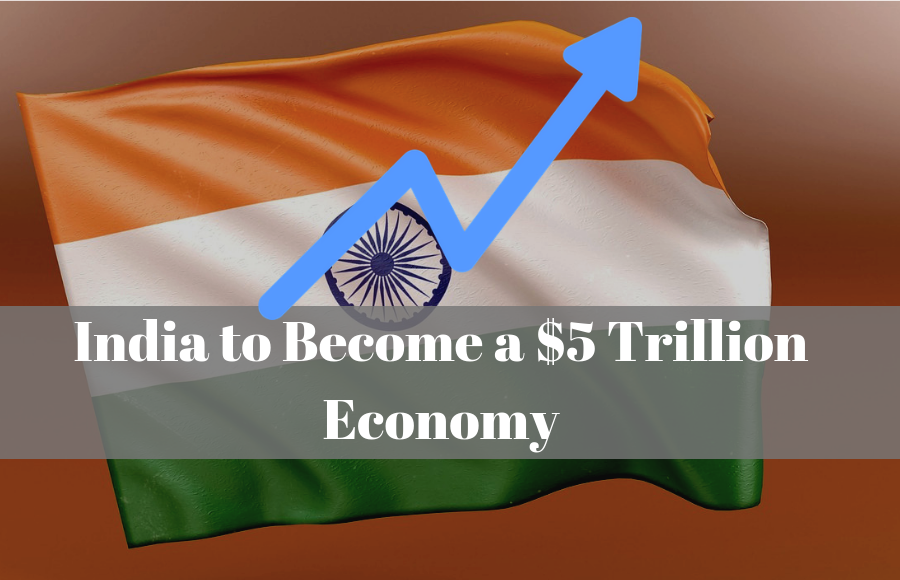The Economic Survey, 2019, tabled in Parliament on Thursday, July 4, laid down the vision of turning India into a USD $5 trillion economy over the next five years.
Chief Economic Adviser to the Central Government, Krishnamurthy Subramanian, presented the survey which focuses on creating a ‘virtuous cycle’ for the Indian economy. This virtuous cycle, he said, would comprise of three basic elements, namely exports, savings, and investments.
Moving Towards a $5 Trillion Economy
If managed successfully, this plan could lead the country into having a sustained growth rate of 8 percent, which would, over the next five years, enable India to become a $5 trillion economy.
According to the survey, the GDP is expected to grow by 7 percent this fiscal year, slightly more than the 6.8 percent expansion achieved by the Indian economy in 2018-19.
Dr. Subramanian prefaced the survey by saying that his team was guided by an unfettered approach to conceptualizing the country’s economic model, also known as the ‘blue sky’ approach.
Blue Sky Approach to Economic Policy
Blue sky thinking encourages unshackled brainstorming with no hard and fast rules or limitations. It is an approach to idea generation which does not require the ideas to follow a pre-defined model or be grounded in any pre-established rules.
The authors of the survey wrote that when the economy of a nation is in a virtuous cycle, investment, demand, enhanced productivity, job creation, and exports all feed into one another to facilitate exponential growth and expansion.
A rising tide, as they say, lifts all boats.
However, the authors warned, the opposite is true when the economy falls into a vicious cycle, with lower rates of investment, demand, job creation, and exports all working together to further dampen each other and cause recession in the economy.
Private Investment and Fiscal Consolidation
Dr. Subramanian, while presenting his first survey, underscored the importance of private investment as a key driver of economic activity, demand, labor productivity, capacity expansion, job creation, and new technology adoption. Further expounding on the topic, he said:
“What we have tried to talk about is that investment is really critical.”
The emphasis on investments by the private sector also meant that the government must stick to the glide path of fiscal consolidation that had been set in motion during the first Modi government.
Modi 2.0 is committed to maintaining a fiscal deficit of no more than 3.4 percent of the national GDP in 2019-20. Over the next two years, the fiscal deficit will be further moderated so that it doesn’t exceed 3 percent of GDP.
Dr. Subramanian said that over the last five years, the government had done a very good job of sticking to the glide path of fiscal consolidation and must continue in the same manner over the next half a decade.
This, he said, would help move the economy into a virtuous cycle of higher investment, greater productivity, and improved demand.
Promoting the Growth of Small and Medium Enterprises
Policy certainty, the adoption of certain norms and practices, and legal reforms would also be required to give a boost to economic growth. Reducing the cost of capital, promoting the growth of MSMEs, and merging the numerous government-held datasets into a single unit would help the country move forward towards a brighter economic future.
The survey also said that, as data is generated by the people, it must therefore be viewed and treated as a public good and used for the delivery of services.
Promoting the growth of medium and small enterprises was another issue highlighted in the survey. Dr. Subramanian pointed out the fact that despite accounting for over 50 percent of all manufacturing firms in the country, small companies with less than 100 workers only employed 14 percent of the workforce in the industry and contributed 8 percent to productivity.
Hence, he concluded that there was a need to snap open the restraints on MSMEs, so that they could grow into larger organizations and enhance the level of their contribution.
Labor, Capital, and Economic Growth
Traditionally, there has been a fear among policymakers that high investment rates might result in labor being replaced by capital. However, the authors of the survey concluded that this was a misguided fear, as evidenced by the success of the Chinese model.
China, despite being a country with very high rates of investment, also created the largest number of jobs. This is because the production of capital goods, supply chains, and research and development also require labor and generate jobs. Thus, the investment of capital directly fosters job creation in the economy.
With the right labor reforms, the survey said, India could enhance the rate of job creation as well as labor productivity across states over the next few years.
![]()



